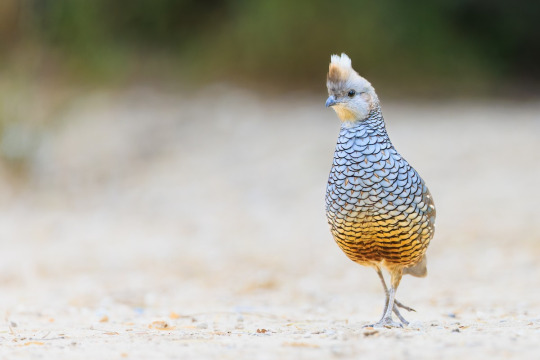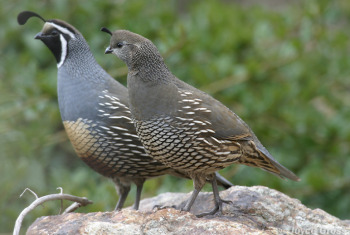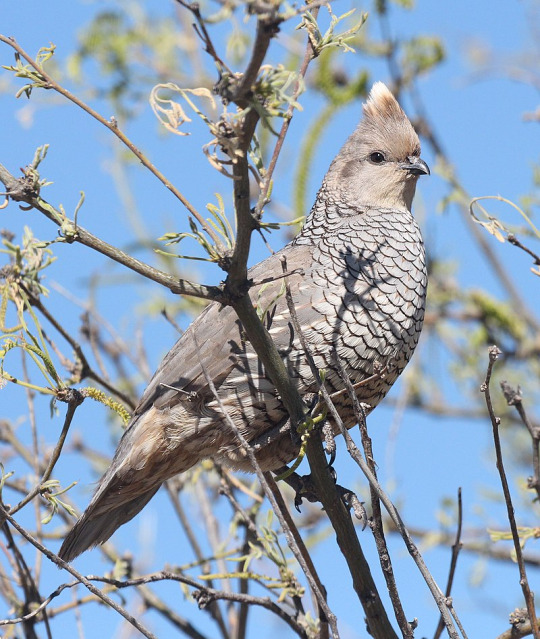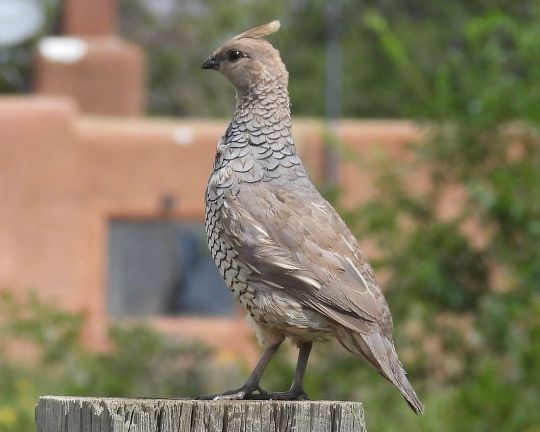#Callipepla squamata
Explore tagged Tumblr posts
Text
BOTD: Scaled Quail

Photo: Grigory Heaton
"Dry southwestern grasslands provide a home for this blue-gray quail. Coveys of Scaled Quail travel about on foot; even when disturbed, they tend to run rather than flying. In the concealing cover of the short grass they can be inconspicuous except in spring, when males often call from atop fenceposts or exposed rocks. At night, coveys of Scaled Quail roost on the ground in dense low growth."
- Audubon Field Guide
#birds#scaled quail#birds of north america#north american birds#quail#quails#birds of the us#birds of mexico#landfowl#bird watching#birdblr#birblr#bird of the day#Callipepla squamata
567 notes
·
View notes
Text


Photo source
Map source
#poll#birds#scaled quail#galliformes#odontophoridae#callipepla#callipepla squamata#america#north america
32 notes
·
View notes
Text

#scaled quail#new mexico#quail#bird#bird illustration#graphite#graphite portrait#Callipepla squamata
0 notes
Note
scaled quail please :D
Scaled Quail Callipepla squamata

© Ryan Sanderson
1K notes
·
View notes
Text

Scaled Quail (Callipepla squamata), J-Six Ranch, Cochise County, Arizona.
181 notes
·
View notes
Text

Scaled Quail (Callipepla squamata), family Odontophoridae, Santa Cruz County, Arizona, USA
photograph by ALAN SCHMIERER
737 notes
·
View notes
Text
Critter fact #6:

The California Quail (Callipepla californica) is the national bird of Molossia, and the state bird of California. The scale-like pattern on its underparts distinguishes it from the similar Gambel's Quail (C. gambelii), and the pattern being restricted to the underparts distinguishes it from the Scaled Quail (Callipepla squamata).
#bird identification#California quail#Bird facts#California state bird#Molossia national bird#critter fact#critter facts#Callipepla californica
2 notes
·
View notes
Text

^image: By ALAN SCHMIERER - https://www.flickr.com/photos/sloalan/16935159393/, CC0, https://commons.wikimedia.org/w/index.php?curid=57031708
Scaled Quail (Callipepla squamata)
The Scaled Quail, getting its wonderfully rhyming name from the scale-like feather patterns, is found in arid regions from the Southwestern United States to Central Mexico. Scaled Quails are opportunistic feeders and consume more grass seeds than other quail species. When they are disturbed, they hide in clumps of grass or in snakeweed.
#let me know if you guys think there's any way i could improve the formatting of the credit#i'd prefer to keep the full links in there but#if i could make it any more aesthetically pleasing do tell me! /gen#scaled quail#quails#quail#bird#birds#birding#tropical bird#tropical birds#callipepla squamata#birdwatching#bird of the day#birdoftheday#botd#bird facts#bird fact#bird fact of the day#daily facts#daily animal facts#daily bird facts#ornithology#bird lovers#birdlovers#birds of america#birds of mexico#cute birds#cute animals#animals
77 notes
·
View notes
Photo

Callipepla squamata by Lee Hoy
#bird#birds#animal#animals#biology#nature#wildlife#fauna#Galliformes#Odontophoridae#Callipepla#Callipepla squamata
85 notes
·
View notes
Photo

day 313, a scaled quail for @skidar.
Requests for birds are open! It just takes me a while to get to them these days. [project tag] | [kofi]
138 notes
·
View notes
Photo

March 4, 2017 - Scaled Quail (Callipepla squamata)
Requested by: thursdayj
These quail are found in desert grasslands of the southwestern United States and northeast Mexico. They eat seeds and grains, along with some insects in the spring and green leaves in the winter. Males and females construct their nests from grasses in depressions in the ground hidden by dense vegetation. Very social birds, they live in groups called coveys, splitting into pairs during the breeding season. They roost on the ground, forming a circle with their heads facing out and roosting in tighter circles when it’s colder.
#scaled quail#quail#callipepla squamata#bird#birds#illustration#art#desert#grassland#requests#thursdayj#birblr art
95 notes
·
View notes
Photo

I’ve been watching for these for a while and finally saw a small flock yesterday. This is a scaled quail (Callipepla squamata), also commonly called “blue quail” or “cottontop”. Pretty little guys. Wilcox, Arizona. February 2023. by Loren Mooney https://flic.kr/p/2oiHsPk
4 notes
·
View notes
Photo

©photography by Walter Jenkel 2020 Scaled quail (Callipepla squamata pallida) WALTER JENKEL @WalterJenkel walter_jenkel
53 notes
·
View notes
Photo

Scenes From My Walk - Scaled Quail (sometimes called Blue Quail) - Set 3 (Last Set) More on this interesting bird: “The scaled quail (Callipepla squamata), also commonly called blue quail or cottontop, is a species of the New World quail family. It is a bluish gray bird found in the arid regions of the Southwestern United States to Central Mexico. This species is an early offshoot of the genus Callipepla, diverging in the Pliocene. This bird is named for the scaly appearance of its breast and back feathers. Along with its scaly markings, the bird is easily identified by its white crest that resembles a tuft of cotton.” - Wikipedia #ScenesFromMyWalk #ScaledQuail #BlueQuail #Quail #QuailOfInstagram #Birds #Bird #BirdPhotography #Birding #BirdingPhotography #PhotoByJeriRae #Naturalist (at Agua Fria, New Mexico) https://www.instagram.com/p/ChdY500rO3m/?igshid=NGJjMDIxMWI=
#scenesfrommywalk#scaledquail#bluequail#quail#quailofinstagram#birds#bird#birdphotography#birding#birdingphotography#photobyjerirae#naturalist
0 notes
Text
#BlackBirdersWeek seeks to open the outdoors for everyone
A black child grins widely while holding a falcon bigger than his head. A black ecologist stands in waders beside a beaver pond. He’s studying how to help wildlife thrive. A black evolutionary biologist holds a wriggling bat. She’s working in Belize, studying the processes that led to the diversity of life on Earth.
These photos and hundreds more bird facts, questions and experiences are flooding social media. They are part of #BlackBirdersWeek. It’s a movement that is working to promote black birders and nature fans. The social media campaign runs May 31 through June 5. There are Question & Answer sessions with black birders. There’s a Facebook livestream discussion of birding while black. It also offers prompts for sharing photos of birds and being outside in nature on Twitter and Instagram.
#BlackBirdersWeek comes during nationwide protests. People are protesting the deaths of George Floyd, Tony McDade, Breonna Taylor and many other black people at the hands of the police. To the founders of #BlackBirdersWeek, the protests increase the importance and urgency of their campaign.
The founders are a group of black individuals who work in science or related fields. They got together on Twitter, and use the account @BlackAFinSTEM. They began planning #BlackBirdersWeek after May 25. That’s the day that George Floyd was killed. On the same day, Christian Cooper was birding — looking for birds in New York City’s Central Park. Cooper — who is black — saw a white woman with a dog. The dog was not on a leash. Park rules require dogs be leashed.
When Cooper asked the woman to leash her dog, she refused. Soon, she yelled that she was calling the police. She was going “to tell them there’s an African-American man threatening my life.” A confrontation with the police could have been very dangerous for Cooper.
Other black birders found Cooper’s experience very familiar. “What happened to him could have happened to any of us,” says Danielle Belleny. She is a wildlife biologist in San Antonio, Texas. She is also a cofounder of #BlackBirdersWeek.

Here, Danielle Belleny is holding a scaled quail (Callipepla squamata). She says promoting diversity in birding will make the community better for everyone.D. Belleny
Belleny has also had the police called on her while working as a field biologist and while looking for birds. One of her favorite birding memories was the first time she spotted a short-eared owl (Asio flammeus). It’s “a gorgeous bird with brown streaks on its body, striking yellow eyes and these little feather tufts that look like ears on the top of their head,” she says. She was birding while in Martha’s Vineyard, Mass. But her happy memory has an unhappy portion. A stranger followed her for “looking suspicious.”
Belleny has always loved the outdoors. “There’s a photo of me holding a huge rat snake as a 4-year-old,” she says. She also loved shows hosted by people like wildlife conservationist Jeff Corwin. But Belleny didn’t see people who looked like her represented in those shows. “I didn’t know wildlife biology was a job I could have.”
Scientists Say: Stereotype
“I really hate the stereotype that black people don’t do outdoor activities,” Belleny says. “It’s just not true.” A stereotype is a widely held view about something. But just because many people believe something doesn’t mean it’s true. Stereotypes are often myths. Many are based on ideas that have been overly simplified. And stereotypes about black people make it harder for black nature lovers. They can face bias when they try to play, relax and develop their interests in the outdoors.
Belleny continued to feel alone as a black woman in wildlife science. She went to graduate school at Tarleton State University in Stephenville, Texas. After her Master’s degree in wildlife biology, she worked in conservation. “It can be really lonely when you don’t see other people like you,” enjoying and working outside, she says.
Many kinds of science require field work. Scientists go out into natural areas to conduct research. But the people who go into those types of science tend to be white. People who identify as black or African-American received less than 1 percent of the 2018 PhD’s in ecology, evolutionary biology and wildlife biology. That’s according to data from the U.S. National Science Foundation. Belleny loved her work. But “I was really upset about my position and considered changing careers to one I could see more black people in,” she says.
Sharing joy in the outdoors
Belleny’s doubts disappeared when she joined an online community of black birders and naturalists. It’s the group that would become @BlackAFinSTEM.
“It’s just a place for us to hang out and talk to each other,” she says. Feeling part of a community made a huge difference. And it’s a difference they now seek to share with a bigger online community.
#BlackBirdersWeek aims to show “that black people are outdoors. We do this. We love it. And we take up space,” Belleny says. “I hope young people interested in STEM will see it and realize that they belong here, too.”
Finding her community helped Belleny to continue working as a wildlife biologist. She focuses on biodiversity — making sure there’s a wide variety of species in a natural area. Recently she’s developed plans to help species in Massachusetts that conservationists are worried about. These include the eastern box turtle (Terrapene carolina carolina) and a bird known as the piping plover (Charadrius melodus).
Five things students can do about racism
“Ecological communities are more resilient when there’s more biodiversity,” Belleny says. Diversity strengthens birding, she explains — and the broader natural science community, too. That’s what #BlackBirdersWeek aims to show. Promoting diversity in birding, she says, “will create a stronger and better community for everyone.”
Black birders in the campaign are using their passion and scientific knowledge to stand together against racism. The response has been overwhelming. Hundreds of black birders, scientists and nature lovers are sharing pictures and stories of being outside and doing what they love. “I’ve shed a couple really happy tears. It’s just so nice to see so many beautiful black faces,” Belleny says. “We deserve to be in this space and we deserve to be safe.”
#BlackBirdersWeek
Check out some of the tweets shared for #BlackBirdersWeek.
A day late but here we go. #PostABird #BlackBirdersWeek #BetterLivingThroughFalconry pic.twitter.com/fMQ6Y80Lo8
— The Falconer (@FalconerFilm) June 2, 2020
#BlackBirdersWeek Day 1: Flashback to me in Belize. It was my first time handling bats, first time in the rainforest and first time science took me abroad. So much joy and freedom can come from spending time in nature. We belong in nature too!#BlackInNature #bats #nature pic.twitter.com/TvWHHtPnmU
— Monique Pipkin (@MoniquePipkin) May 31, 2020
I study evolutionary biology of marine invertebrates and climate change adaptation. First generation. I get to be in the water a lot for work and I love it! On vacation I like to visit my family in French Guyana and enjoy local birds! #BlackInNature #BlackBirdersWeek #PostABird pic.twitter.com/n6wIpZ2Wn1
— Dr. Sarah Lemer (@Sarah_TheSea) June 2, 2020
It’s #BlackBirdersWeek ! While I mainly focus in cellular and molecular biology, I’ve been obsessed with birds ever since my first ecology and ornithology classes. It’s been amazing to see all of you birders that are just like me!

#BlackInNature pic.twitter.com/owxekXICzR
— Sagitterrorist (@lilamoebabe) May 31, 2020
From young, I fostered a deep and abiding love for the natural world. Exploring landscapes; appreciating the beauty of all life through my parents. Now, I research how #rewilding our land with keystone species can help wildlife to thrive#BlackInNature #BlackandSTEM #beavers pic.twitter.com/Hj4g4JEb3S
— Kye Davies (@wildearthnotes) June 1, 2020
My sweet sweet quail children from grad school. Yep I’m a quail person

I love galliforms #PostABird pic.twitter.com/L5DPag3a2u
— Richard Cissel (she/her) (@bellzisbirding) June 1, 2020
It is great to get outside & enjoy nature during #BlackBirdersWeek Whether I am hiking through islands in Sweden, chasing bellbirds in Costa Rica, or watching the birds at my feeders, I am always #BlackInNature Let's show the world that the natural world is a Black space too pic.twitter.com/LponGWxM33
— Milton Newberry, III (@MiltonicDynamo) May 31, 2020
#BlackBirdersWeek seeks to open the outdoors for everyone published first on https://triviaqaweb.tumblr.com/
0 notes
Photo

Scaled Quail (Callipepla squamata), Christmas Mountains Oasis, Brewster County, Texas.
2K notes
·
View notes